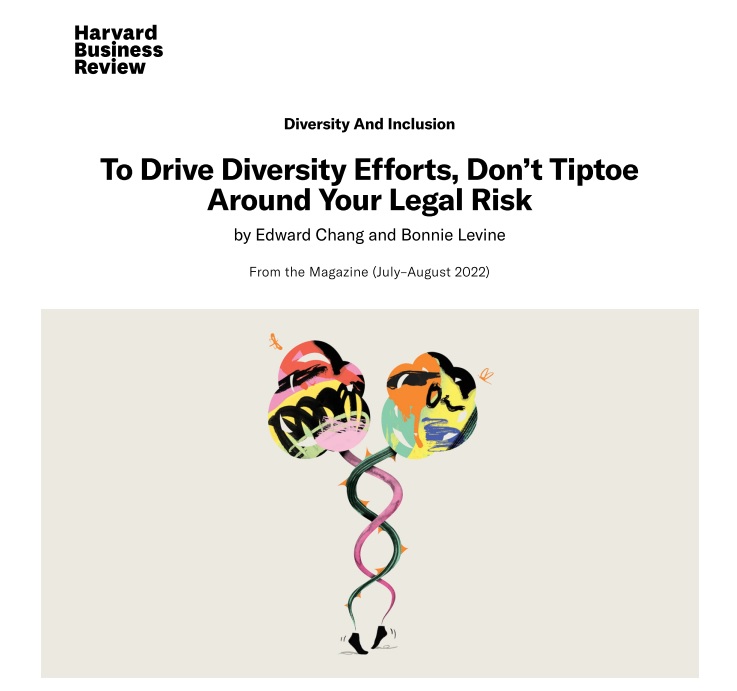Good DEI is worth the risk, assuming timely engagement with legal counsel
Posted September 1, 2022
SHARE

The difference between bad DEI and good DEI often hinges on the timing and quality of legal counsel’s involvement in the conversation, according to a Harvard Business Review article co-authored by Verse Legal Attorney and Founder Bonnie Levine. If they are willing to involve legal counsel in open conversations from the get-go, companies can pursue DEI initiatives that align with their values, achieve meaningful change, and avoid the dangers of performativity.
Too often, DEI leaders and other executives run diversity-related initiatives by legal counsel at the last possible minute before taking them live, wrote Bonnie and co-author Dr. Edward Chang of the Harvard Business School. This can lead to attorneys hastily assessing DEI proposals from a defensive angle that prioritizes avoidance of one set of risks while leaving the company vulnerable to more insidious and potentially more damaging risks.
This late-stage engagement “serves nobody well because it can reinforce as ‘safe’ outdated or performative DEI practices that have been shown to be ineffective,” the article says. “And ineffective DEI, particularly when perceived as noncommittal and inauthentic, can cause a host of problems: It can harm recruiting efforts, damage employee morale, drive employee concerns underground, and even invite lawsuits.”
Most companies understand that no meaningful business initiative is entirely risk-free. Yet they often fail to make the same nuanced risk-management decisions in DEI that they apply in other key business areas. Under-resourced and poorly understood DEI teams may feel that their only hope of getting anything done lies with avoiding the legal department as long as possible. But a “vicious cycle” ensues when attorneys are asked to review a DEI proposal but lack the time and context necessary to help advance the company’s DEI goals while enabling executives to make informed decisions about acceptable risk-taking.
So what are some of those risks? The HBR article points to, for example, corporate DEI initiatives focused on hiring diverse candidates. Fearful of so-called “reverse discrimination” complaints, “lawyers tend to run away screaming from any suggestion that demographic factors have been or will be considered in employment decisions.”
Companies may then let this fear, however ungrounded in actual case law, drive their DEI decisions and perpetuate unlawful discrimination against historically underrepresented groups.
An attorney who lacks the time to adequately understand the goals behind DEI proposals and to research the legal nuances of the inherent risk calculation may throw cold water on such proposals. This can put companies in the much riskier position of performing DEI without actually living DEI:
[B]ad DEI poses greater legal risk than good DEI does. Most lawyers would agree, after all, that when a party acts or speaks in a way that misrepresents reality—as is often the case with DEI conducted in bad faith—that party is creating legally damaging evidence, no matter what the context. Lawyers also know that when it’s serious enough, a misrepresentation alone can create liability and make people mad enough to sue.
A more productive, honest approach to DEI requires a clear “structural and procedural foundation,” where stakeholders understand when and how to seek legal advice and what the workflow for doing so looks like.
It is also important to bring in legal counsel early and provide them with the necessary context for understanding the goals and nuances of DEI initiatives, rather than seeking rubber-stamp approval at the last minute.
And perhaps most importantly, organizations and their legal counsel need to interrogate their own understanding of risk. Good DEI often entails uncomfortable, meaningful change, and it is easy to mistake that discomfort for unacceptable legal risk. But when organizations work with counsel to “go deeper” and understand “the risks not only of action but also of inaction,” they can achieve meaningful progress in DEI and earn the lasting trust of their employees.

